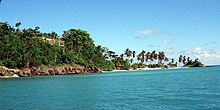There are many small offshore islands and cays that are part of the Dominican territory. The two largest islands near shore are Saona, in the southeast, and Beata, in the southwest. To the north, at distances of 100–200 kilometres (62–124 mi), are three extensive, largely submerged banks, which geographically are a southeast continuation of the Bahamas: Navidad Bank, Silver Bank, and Mouchoir Bank. Navidad Bank and Silver Bank have been officially claimed by the Dominican Republic.
The country's mainland has four important mountain ranges. The most northerly is the Cordillera Septentrional ("Northern Mountain Range"), which extends from the northwestern coastal town of Monte Cristi, near the Haitian border, to the Samaná Peninsula in the east, running parallel to the Atlantic coast. The highest range in the Dominican Republic – indeed, in the whole of the West Indies – is the Cordillera Central ("Central Mountain Range"). It gradually bends southwards and finishes near the town of Azua, on the Caribbean coast. In the Cordillera Central are found the four highest peaks in the Caribbean: Pico Duarte (3,098 metres or 10,164 feet above sea level), La Pelona (3,094 metres or 10,151 feet), La Rucilla (3,049 metres or 10,003 feet) and Pico Yaque (2,760 metres or 9,055 feet).
In the southwest corner of the country, south of the Cordillera Central, there are two other ranges. The more northerly of the two is the Sierra de Neiba, while in the south the Sierra de Bahoruco is a continuation of the Massif de la Selle in Haiti. There are other, minor mountain ranges, such as the Cordillera Oriental ("Eastern Mountain Range"), Sierra Martín García, Sierra de Yamasá and Sierra de Samaná.
Between the Central and Northern mountain ranges lies the rich and fertile Cibao valley. This major valley is home to the city of Santiago and most of the farming areas in the nation. Rather less productive is the semi-arid San Juan Valley, south of the Central Cordillera. Still more arid is the Neiba Valley, tucked between the Sierra de Neiba and the Sierra de Bahoruco. Much of the land in the Enriquillo Basin is below sea level, with a hot, arid, desert-like environment. There are other smaller valleys in the mountains, such as the Constanza, Jarabacoa, Villa Altagracia, and Bonao valleys.

Cayo Levantado in Samana Bay is one of the many
cays in the D.R.
A few other small coastal plains are in the northern coast and in the Pedernales Peninsula.
Four major rivers drain the numerous mountains of the Dominican Republic. The Yaque del Norte is the longest and most important Dominican river. It carries excess water down from the Cibao Valley and empties into Monte Cristi Bay, in the northwest. Likewise, the Yuna River serves the Vega Real and empties into Samaná Bay, in the northeast. Drainage of the San Juan Valley is provided by the San Juan River, tributary of the Yaque del Sur, which empties into the Caribbean, in the south. The Artibonito is the longest river of Hispaniola and flows westward into Haiti.
There are many lakes and coastal lagoons. The largest lake is Enriquillo, a salt lake at 45 metres (148 ft) below sea level, the lowest point in the Caribbean. Other important lakes are Laguna de Rincón or Cabral, with freshwater, and Laguna de Oviedo, a lagoon with brackish water.
Bajos de Haina, 12 miles (19 km) west of Santo Domingo, was included on the Blacksmith Institute's list of the world's 10 most polluted places, released in October 2006, due to lead poisoning by a battery recycling smelter closed in 1999. Cleanup of the site began in 2008, but children continue to be born with high lead levels, causing learning disabilities, impaired physical growth and kidney failure.
Climate
The climate of the Dominican Republic is mostly tropical.

